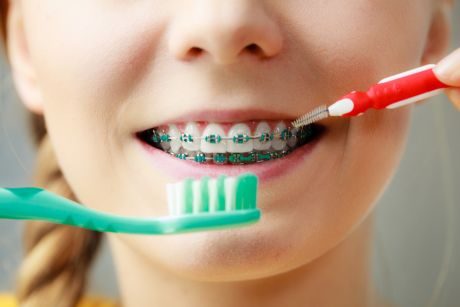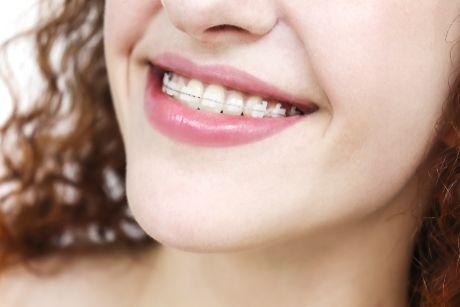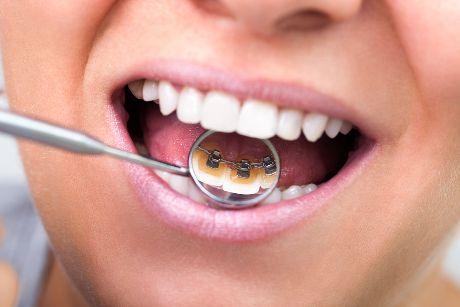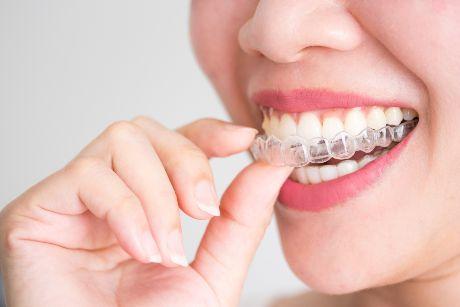
An Honest Guide to Teeth Straightening

If you’re on this page, then chances are you’re looking at teeth straightening options for yourself or a loved-one and just need to know more about your options.
Traditionally, fixing crooked or uneven teeth was undertaken during adolescence, a short time after all adult teeth have come through. However, there have been some major improvements in the orthodontic process over the past few years, notably with regard to the options available. As a result, many older teens and adults who have missed the traditional adolescent window are increasingly looking into teeth straightening options.
However, with this rise in technology and teeth-straightening treatments, there is often more confusion surrounding the different types of teeth straightening options.
Which is why we’ve put together this guide to teeth straightening and orthodontics - a simple guide that breaks down confusion and gives you the key information needed to help you on the journey to achieving a perfect smile.
What is Orthodontics?
Orthodontics is a specialty in dentistry that focuses on the prevention and correction of crooked, protruding or misaligned teeth. Put simply - it’s the area of practice that covers teeth straightening. Orthodontics (i.e. teeth straightening) can often be a crucial treatment for patients who have misaligned teeth, as not only does it affect your appearance, but ensuring teeth meet correctly when they bite helps ensure better tooth hygiene and reduces the chance of damage to prominent teeth.
What’s the Difference Between an Orthodontist and a Dentist?
An orthodontist is a qualified dentist who has pursued an additional specialized qualification in Orthodontics. Their area of expertise primarily revolves around the alignment of teeth and jaw. Dentists and orthodontists are both medical practitioners who specialize in the care of teeth and gums, although dentists primarily focus on general dental procedures like root fillings, crowns, and bridges.For more information, read our recent article on our (very talented!) Orthodontist, Adriana Vidal.
Can I get my teeth straightened on the NHS?
Orthodontic treatment is available free of charge on the NHS, but only for young people under 18, or students up to the age of 19. Additionally, free treatment is only valid if the treatment is for a ‘serious’ condition - smaller problems can be classified as cosmetic and therefore don’t qualify for free treatment.
Adults and older teens therefore have to seek private options. Private treatments are widely available though and at Life Dental we have an experienced and friendly team of orthodontists who can talk you through the process and individual needs.
Going private for orthodontic work can often be daunting for many, but the costs for orthodontic work are often more affordable than many initially think.
How much does tooth straightening cost?
A lot of factors affect the cost of othodontic treatment. Key factors determining the cost are the selected method for straigtening your teeth and the extent of the treatment. An exact cost can only be determined after an initial consultation with an orthodontist who will assess your teeth and discuss the available options.How long do braces take to straighten teeth?
The total length of treatment depends a lot on how severe the misalignment of your teeth is and the type of brace chosen. For most cases, treatment takes around 12-18 months from the initial consultation to beautifully straight teeth. If the misalignment is minor it's possible for treatment to be completed in less than a year. A more accurate timeline can be determined during your first consultation when the orthodontist can get a good look at how much work is required.
What are the most popular methods of tooth straightening?
Traditional Braces

Traditional Braces, also known as Metal Fixed Braces, are the type of braces that are commonly recognized. They comprise small metal brackets that are adhered to the teeth and joined together using a slim wire. These wires can be adjusted separately to shift the teeth into the desired alignment.
Advantages
- Control: The metal brackets and wires in traditional braces offer strong control of your teeth. Only a dentist can remove them, and because they require regular check-ups (4-6 weeks) your dentist can make sure they’re moving your teeth properly.
- Faster: Given the strong control over your teeth, metal braces will often take a shorter time to straighten teeth compared to removable braces.
- Strength: fixed metal braces mean that they rarely break or become unaligned.
- Cost: Meta braces are often one of the cheaper treatment options
Disadvantages
- Hygiene: As the braces are fixed tightly in place, food can get caught between the metal, so it is very important to regularly clean your teeth and ensure all food is cleared.
- Restrictive: As with the above hygiene issues, you also have to be careful about what you eat to avoid any food causing the brackets to move. So that means temporarily waving goodbye to harder food like nuts, hard sweets, corn on the cob and even apples.
- Visibility: Traditional braces are one of the most visible of braces, which can be an important factor for those who want more subtle orthodontic treatment.
Ceramic Braces

Ceramic braces closely resemble metal fixed braces, but as they are crafted from ceramic material, they often appear transparent or the same shade as teeth. This discreet and inconspicuous alternative is preferred by those who feel conscious about having braces.
Advantages:
- Visibility: Whilst still fairly visible, they are often clear or tooth-coloured making them a lot more subtle in appearance than metal braces.
- Strength: Ceramic braces offer the same control as metal braces
- Time: Similar to metal braces, ceramic braces offer a quicker orthodontic process compared to removable braces.
Disadvantages:
- Size: Ceramic braces are often larger than metal braces, which can make it harder to clean around the braces, leading to sensitivity issues.
- Durability: Ceramic braces are not as strong as metal and therefore more susceptible to fracturing.
- Staining: Being of a clear - light colour, ceramic braces can be more susceptible to staining, so you may wish to stay away from food and drink that can potentially stain your braces (e.g. coffee, curry and red wine).
Lingual Braces

Lingual braces are similar to traditional fixed braces, with the crucial difference being that they fit behind your teeth. Otherwise, they work the same as fixed braces - i.e metal brackets and wires that are designed to manipulate the teeth into the correct position.
Advantages:
- Discreet: The biggest advantage of lingual braces is that they are situated behind the teeth. This means that lingual braces are near-invisible to the casual observer.
- Strong: Again, lingual braces are functionally the same as fixed metal braces, which means they will rarely break or become misaligned.
Disadvantages:
- Cost: Lingual braces can often be a more expensive option than traditional braces or clear aligners like 32co. The cost increase is down to the brace itself costing more, plus more training is often required for Orthodontists to learn the specific technique.
- Restrictive: Like Traditional braces, you’ll have to avoid hard foods, or ones that can get caught in the brackets. So no more popcorn at the cinema for a while!
Clear Aligners

Clear aligners are made of hard plastic that can be taken out and are custom-fitted to your mouth. They are becoming increasingly popular among both teenagers and adults due to their barely noticeable appearance. Unlike other options, these braces do not directly attach to your teeth, therefore they need to be regularly examined and replaced during the initial months of treatment to guarantee proper alignment of your teeth.
Advantages:
- Appearance: the most obvious benefit of clear aligners is that their almost invisible appearance, especially when compared to metal and ceramic braces.
- Comfort: Aligners are similar in appearance to a standard mouthguard and therefore a lot more comfortable than metal or ceramic.
- Removable: Being fully removable you don’t need to worry about not eating foods that can get caught in/damage your braces.
Disadvantages:
- Removable: Yes, removable is also an advantage, but it can also be seen as a downside. Taking out your clear aligner is really only for eating and twice-daily oral hygiene. However, their ability to be easily removed can make it tempting to remove for other occasions. Self-discipline is therefore key when it comes to using clear aligners otherwise they simply won’t be as effective.
- Inconvenience: Another example where clear aligners benefit of removability can be a drawback. For those who constantly graze throughout the day, or are partial to regular teas or coffees - removing clear aligners and cleaning teeth before reinsertion can swiftly become wearisome.
Do braces permanently straighten teeth?
It is perfectly normal for some minor tooth movement to happen over a long time after orthodontic treatment. However, in the vast majority of cases, teeth do not move enough after the teeth straightening process to warrant any further treatment.
Who can I talk to about getting teeth straightening in Exeter?
If you're looking for an Exeter dentist that offers comprehensive teeth-straightening treatments, Life Dental has a specialized Orthodontic team ready to guide you through your teeth-straightening process in detail and see which method is best for your teeth, your lifestyle and your overall well being.
Contact the Exeter dental team now for a consultation and let’s work together to achieve that perfect smile!




